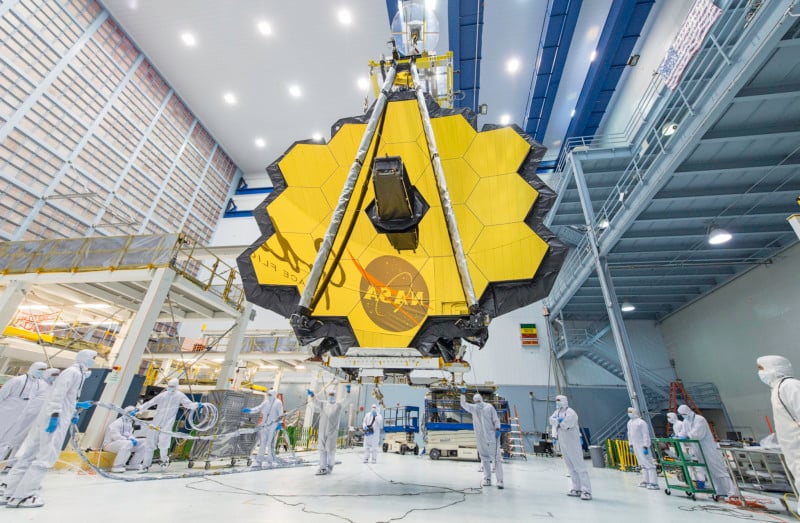The James Webb Space Telescope’s alignment is now complete and is confirmed to be able to capture sharp, perfectly crisp images with all four of its instruments.
Webb completed its seventh and final stage of telescope alignment, after which the team behind the observatory met and unanimously agreed that it is now ready to move toward its next and final series of preparations, called science instrument commissioning, which will take about two months. After this final stage, Webb will take its first scientific observation photos.
NASA has released an image sharpness check sheet that shows all of Webb’s instruments in full sharpness.
NASA describes the image above:
“Engineering images of sharply focused stars in the field of view of each instrument demonstrate that the telescope is fully aligned and in focus. For this test, Webb pointed at part of the Large Magellanic Cloud, a small satellite galaxy of the Milky Way, providing a dense field of hundreds of thousands of stars across all the observatory’s sensors.
“The sizes and positions of the images shown here depict the relative arrangement of each of Webb’s instruments in the telescope’s focal plane, each pointing at a slightly offset part of the sky relative to one another. Webb’s three imaging instruments are NIRCam (images shown here at a wavelength of 2 microns), NIRISS (image shown here at 1.5 microns), and MIRI (shown at 7.7 microns, a longer wavelength revealing emission from interstellar clouds as well as starlight). NIRSpec is a spectrograph rather than imager but can take images, such as the 1.1 micron image shown here, for calibrations and target acquisition.
“The dark regions visible in parts of the NIRSpec data are due to structures of its microshutter array, which has several hundred thousand controllable shutters that can be opened or shut to select which light is sent into the spectrograph. Lastly, Webb’s Fine Guidance Sensor tracks guide stars to point the observatory accurately and precisely; its two sensors are not generally used for scientific imaging but can take calibration images such as those shown here. This image data is used not just to assess image sharpness but also to precisely measure and calibrate subtle image distortions and alignments between sensors as part of Webb’s overall instrument calibration process.”
Webb has performed better than the best expectations to this point, and NASA reports that trend continues. Webb’s mirrors are directing fully focused light that is collected from space to each instrument, and every one of them is successfully capturing images using that light.
“These remarkable test images from a successfully aligned telescope demonstrate what people across countries and continents can achieve when there is a bold scientific vision to explore the universe,” Lee Feinberg, Webb optical telescope element manager at NASA’s Goddard Space Flight Center, says.
NASA says that the images are what is known as “diffraction limited,” which means that the fine details visible in the photos are as sharp and crisp as possible given the size of the telescope. Webb quite literally could not be performing better.

The science instrument commissioning is a process that will see each instrument pointed at different areas of the sky, which will vary the amount of solar radiation that hits the observatory and will allow engineers to confirm thermal stability as it changes targets.
Each of Webb’s instruments is a highly sophisticated set of detectors equipped with unique lenses, masks, filters, and customized equipment and in this stage, each specialized characteristic of these instruments will be configured and operated at various combinations to fully confirm their readiness for scientific observation.
“With the completion of telescope alignment and half a lifetime’s worth of effort, my role on the James Webb Space Telescope mission has come to an end,” Scott Acton, Webb wavefront sensing and controls scientist, at Ball Aerospace, says.
“These images have profoundly changed the way I see the universe. We are surrounded by a symphony of creation; there are galaxies everywhere! It is my hope that everyone in the world can see them.”
Image credits: Photo NASA/STScI, description by Thaddeus Cesari, NASA Goddard
Author: Jaron Schneider
Source: Petapixel



